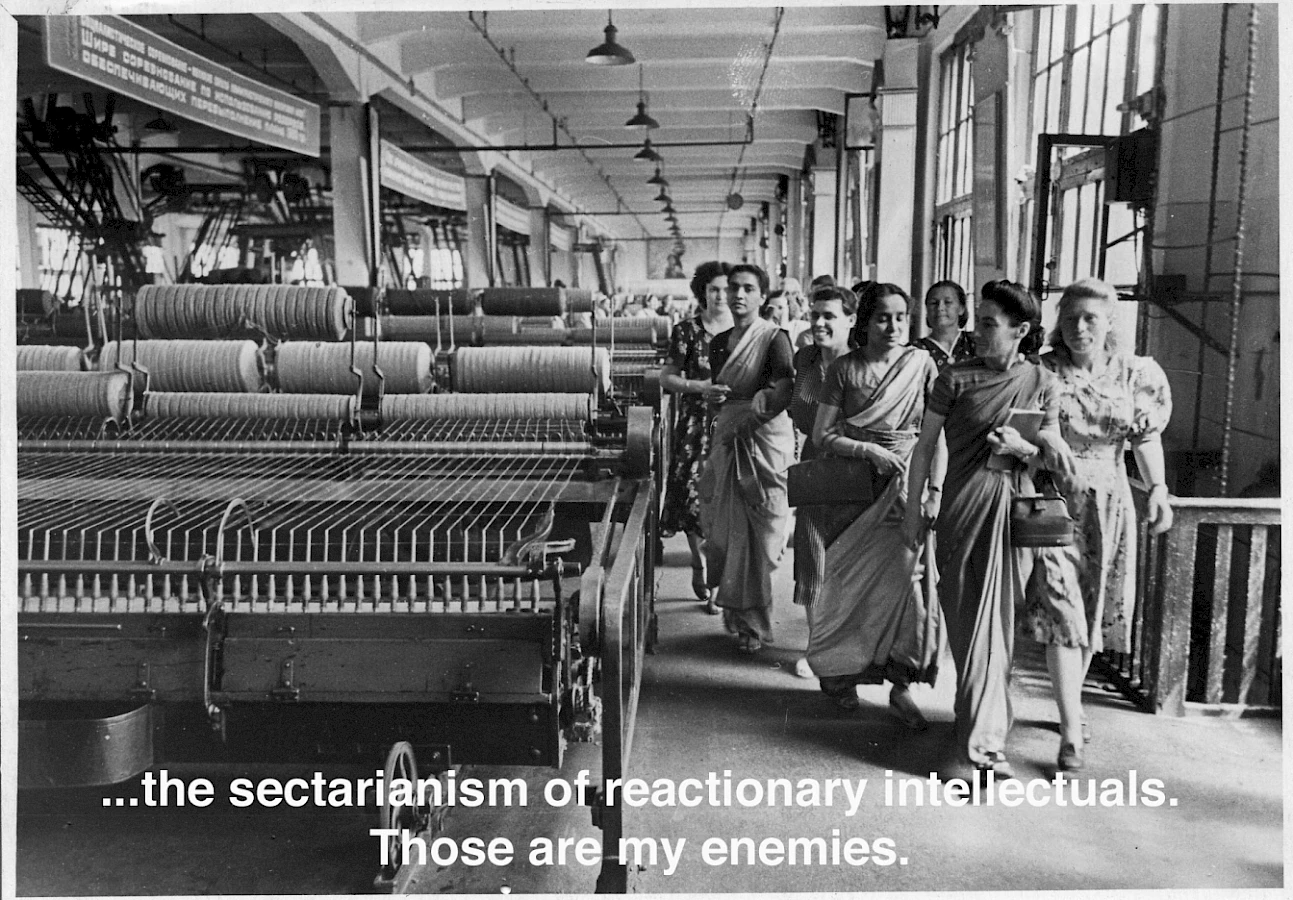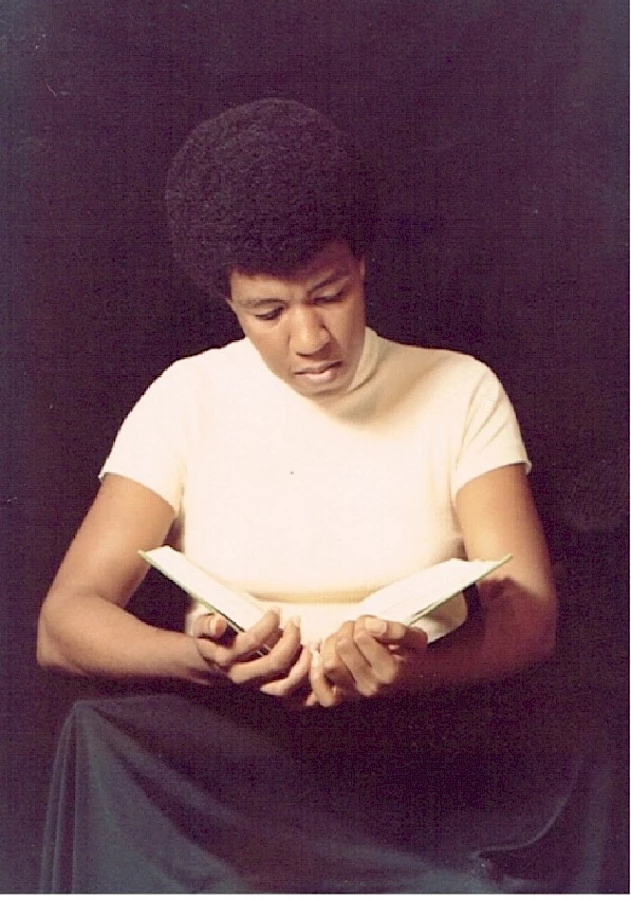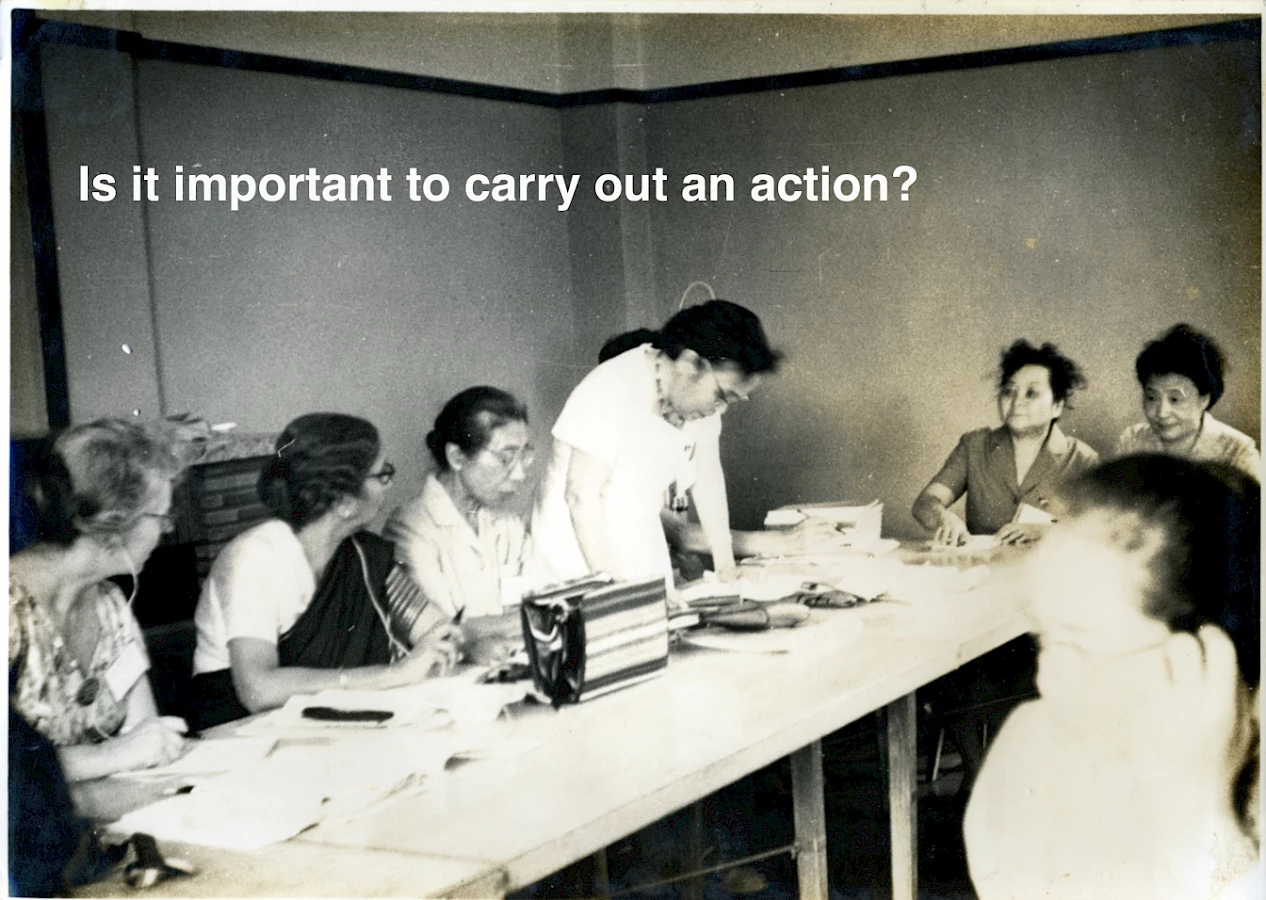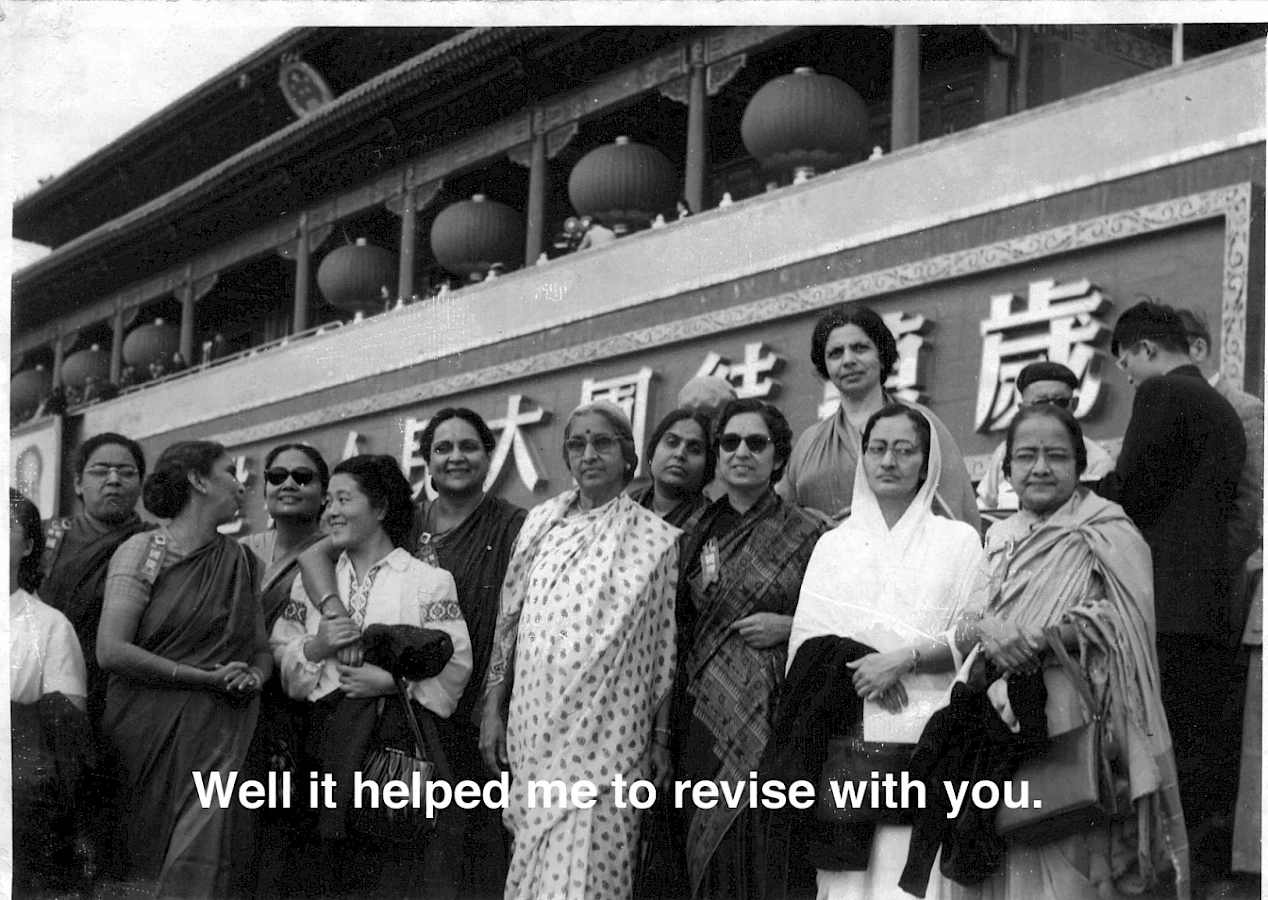Feminism: possibilities for knowing, doing and existing. A conversation between the Otolith Group and Annie Fletcher

The Otolith Group, Communists Like Us, 2009, (film still). Image courtesy the artists.
This conversation took place ahead of the exhibition, Trade Markings, at the Van Abbemuseum in 2018, of which Otolith Group were a part. A mid-career survey of The Otolith Group entitled Xenogenesis curated by Annie Fletcher is planned to open at the Van Abbemuseum in May 2019.
Annie Fletcher: You have mentioned that feminism is a generative force for you both in your work. How do you think about this discipline, about writings around feminism? Is your work essentially feminist work?
Kodwo Eshun: One way of bringing all of these concerns together is around a figure whose thinking I have returned to recently. A figure whose feminist thought condenses many of the obsessions I have: the science fiction novelist Octavia Estelle Butler.

Octavia Butler. Image via openroadmedia.com.
When you read Octavia Butler's feminist science fiction from the 1970s onwards, and then you read feminist theory from the 1980s onwards, you realise that Butler's novels have operated as a critical reference point for several generations of feminist theory. In 1987, Donna Haraway writes A Manifesto for Cyborgs: Science, Technology and Socialist Feminism in the 1980s which she subsequently revises as A Manifesto for Cyborgs: Science, Technology and Socialist Feminism in the Late Twentieth Century in 1991. She is concerned with the cyborgs envisioned by the feminist science fiction written by Americans such as Suzy McKee Charnas, Samuel R. Delany, Anne McCaffrey, Vonda McIntyre, Joanna Russ, James Tiptree Jr., John Varley and Octavia Butler. All of this work, in different ways, Haraway suggests, makes "very problematic the statuses of man or woman, human, artefact, member of a race, individual entity, or body" (Haraway 1987, p. 34) and she devotes particular attention to the figure of Lilith Iyapo in Butler's Dawn, 1988. Haraway describes Iyapo as a character that "mediates the transformation of humanity through genetic exchange with extra-terrestrial lovers/ rescuers/ destroyers/ genetic engineers who reform earth's habitats after the nuclear holocaust and coerce surviving humans into intimate fusion with them" (Haraway 1991, p. 179). She considers Dawn as a novel that works through its interrogation of "reproductive, linguistic, and nuclear politics in a mythic field structured by late twentieth-century race and gender". Dawn is the first book in Butler's Xenogenesis Trilogy, which continues with Adulthood Rites, 1988, and concludes with Imago, 1989. The idea of 'xenogenesis', a word invented by Butler, can be understood as the conjunction of the Greek prefix of xenos meaning strange or foreign or alien with the suffix genesis meaning origin or creation or generation. Thus, the term xenogenesis refers to alien creation or alien becoming or becoming alien. The imagination of the implications of alien becoming and becoming alien takes on epic dimensions. In these books, Butler elaborates a speculative anti-naturalism that prefigures the vehe-ment anti-naturalism of the xenofeminist working group Laboria Cuboniks. In their manifesto XF Xenofeminism: A Politics for Alienation in 2015, Laboria Cuboniks conclude that "in the name of feminism 'Nature' shall no longer be a refuge of injustice, or a basis for any political justification whatsoever! If nature is unjust, change nature!"
From Kindred (1979) onwards, Octavia Butler is thinking through the implications of denaturalisation. Her books explore what happens to gender, sexuality and personhood under conditions of enforced deontologisation. What Octavia Butler shows is that the human or humanity is a revisable project. Under conditions of denaturalisation, the nature of nature, gender, sexuality and kinship gives way. Characters find themselves navigating conditions in which the necessity of survival forces them up against and beyond the limits of what it means to be human. Butler's novels stage thought experiments revisited by feminist philosophers. I think that Butler's writing rethinks the condition of woman in the mode of science fiction. During the 1990s, Sadie Plant engages with Butler's work in order to think through the question of the encounter between computation, control and the figure of woman.
AF: That was a very generative moment, when Sadie Plant was working at the University of Warwick and heading up the Cybernetic Culture Research Unit or CCRU with Nick Land, in 1995–96, wasn't it?
KE: Yes, it was. From the early 1990s through to the publication of Zeroes and Ones in 1998, in dialogue with allies such as the multimedia unit 0(rphan) d(rift>) and the Australian theory collective, VNS Matrix, Plant is thinking through the relationship between women and machines as a question of computation and control. If computation takes control away from man, then computation might be said to operate according to its own ends which are not fully determined by man or by humans or even by capitalism.Computation's non-human logic of control supports women in so far as it allies itself with the figure of woman that is internally-located outside the idea of man that stands in for humanity enforced by Western philosophy (Plant 1998, p. 220). What Butler's fiction offers Plant is the opportunity to compare the gene trading imagined in the Xenogenesis Trilogy with the mutations of asexual replication and the role played by sexual reproduction for securing "the continuity of a species like Homo Sapiens". Plant's focus on replication and reproduction is continued, in different ways, by Luciana Parisi, along with Anna Greenspan and Suzanne Livingston, all of whom studied with Plant and played critical roles within the CCRU. Parisi uses eight quotations from Dawn, Imago and Clay's Ark, as epigraphs in her first book Abstract Sex: Philosophy, Bio-Technology and the Mutations of Desire (Parisi 2004, pp. 59, 66, 72, 145–6, 155, 165, 185).

The Otolith Group, Communists Like Us, 2009, (film still). Image courtesy the artists.
AF: I didn't realise they had been Sadie Plant's students. So they were thinkers in the CCRU at the University of Warwick, along with figures such as Mark Fisher and Steve Goodman? Were you there too?
KE: Yes, they were all at Warwick. I didn't study there but I was an ally and associate member of the CCRU. I wrote for their theory-zine Abstract Culture. I participated in the second of their Virtual Futures conferences at Warwick in 1996. I spoke at syzygy, the collaborative exhibition by CCRU and 0(rphan) d(rift>) at Beaconsfield in South London in 1999. Beyond the 1990s, Parisi has maintained her interest in Butler's ideas. In a recent essay entitled The Incomputable and Instrumental Possibility, written with Antonia Majaca in 2016, Parisi returns to Butler's Dawn to rethink the idea of the instrument and instrumental reason. They consider that Dawn's Lilith Iyapo personifies the figure of the Promethean woman who "reasons with the instrument and from the logic of the instrument" in order to acknowledge, politicise and transcend instrumentality.
The Black Quantum Futurists, or BQF, is a Philadelphia-based collective, founded by artists and writers Rasheedah Phillips and Moor Mother. Over the last decade, BQF's electronic music performances, mixes, essays, fictions, video works and performances constitute an expanded theory and practice for hacking the master clock of Western time. The BQF are developing methodologies of retrocausality and retrocurrence for a community-based chronopolitics that draws upon black radical traditions and African spiritual traditions.1 In this context, Butler's work becomes a critical resource too: in Kindred, 1979, the novelist Dana Franklin is temporally abducted from her contemporary life in Los Angeles in 1976 back to the plantation of Baltimore, Maryland in 1815 where she is forced to rescue Rufus Weylin, her white ancestor, from near death over and over again.
The work of philosopher Denise Ferreira da Silva thinks with Butler in ways that open new grounds for feminist thought. In her essay Towards a Black Feminist Poethics: The Quest(ion) of Blackness Towards the End of the World, 2014, Ferreira da Silva analyses Kindred's Dana, Anyanwu, the shape shifter in Wild Seed, 1980, and Lauren Oya Olamina, the teenage hyperempath in Parable of the Sower, 1993, as figures that guide our imagining of political existence for living in and through and after the end of the world. Dana's traversality, enacted through her enforced movement across time and space, Anyanwu's transubstantiality, which takes the form of the capacity to change into any creature and Lauren's transversability or capacity to feel others' feelings, each exemplify what Ferreira da Silva calls movements made possible "because of the connections that precede time and space, but which operate in time and space". They announce a "speculation on a Feminist Poethics of Blackness" which aims to "emancipate the Category of Blackness from the scientific and historical ways of knowing that produced it in the first place" so as to "announce a whole range of possibilities for knowing, doing and existing" (Ferreira da Silva 2014, pp. 94, 93, 82, 81).2
Butler's feminist science fiction continually returns to exodus, survival, enforced hybridity, addiction, compulsion, symbiosis and asymmetries of belonging. Feminism is inseparable from a profound questioning in which fiction acts as a site for thinking of the limits of the human. The feminism that concerns me puts pressure on what the human is and allows for a speculation that takes on the forms of science fiction. The nexus where science fiction and feminist theory meet is a productive one when you unfold it across thirty years and then keep going. There are many key feminist novelists but it is Butler's work I return to over and over.
AF: Butler clearly has left an important legacy and her writing has clearly influenced generations of intellectual work. Thank you for outlining it so precisely. This trajectory and all of the attendant issues of Butler's feminist science fiction are, in a way, inspirations for your upcoming exhibition at the Van Abbemuseum. In fact you were thinking of calling it Xenogenesis.
KE: Yes. The question of xenogenesis can be understood as a kind of diagramme for the revision of the human. Octavia Butler's diagramme of xenogenesis requires a relation to ontogenesis or the becoming of being, and technogenesis or the becoming of technology. Her novels condense and elaborate these ideas in ways that can guide contemporary political imagination. These are ideas that we can work with and develop according to our own obsessions.
Anjalika Sagar: I think the idea of alienation depends on what you are alienating from. How is the human to be understood? The human is male domination as we understand it now. The idea of the human emerges from within that. We live in a time when women have to do emotional and empathetic labour. They have to do the social labour of knitting relations and keeping things fine while men do very little of that. A lot of men do not do that kind of labour. So there is a sense that women bear the burden of the underworld. In terms of one's genesis as a human being, as a woman, as you get older, especially now that the sense of prominence of the male is being questioned, you begin to realise this depression that you had as you emerged as a young woman, that you live, and have lived with the labour of your own pain. You grow up with this depressing condition that you have taken for the world you live in. That means everything that male domination does: colonialism, pornography...
AF: Just violence generally.
AS: Just violence generally. We can live in a post-patriarchal world. I think it is patriarchy that we have to alienate ourselves from. It is not just becoming alien – which means getting further and further into a shell, because women can never go into a shell. Feminism is a praxis, it is a definitive way of living and learning how to be. And that does not just mean men doing that work.
AF: Absolutely, it is a model for us all.
AS: Men have to do that work. Why should women have to be enthusiastic all the time and be doing all kinds of labour? The sense of how we live in post-patriarchy is what is important. How can we combine and create different forms of education to help people understand what feminism is? I think the point is to intersectionalise feminism with class and with technology and to queer the technology so that we can begin to think about what it is that we want to alienate ourselves from. What is a post-patriarchal world whereby we are still excited by each other and by ourselves and by the world? There has to be joy within this as well.
AF: I agree joy and space for complex emotional life should be core in an intersectional and lived feminist praxis! You spoke recently, when doing an introduction to your work, about how different the feminism you might have had in your life growing up in London was to the kind of praxis that might have been produced in white Britain for example. Could you tell us about the models that you grew up with?
AS: In the West there is a sense that they are the most liberal and modern, that Western feminism was the most liberal, modern phenomenon, meaning that women take the pill, and wear mini skirts. That did not seem to make sense next to another ontological kind of space that I was encountering with Indian women. My grandmother wore saris, did not wear make-up, but was extremely feminine and beautiful. She was a feminist. But her feminism was interlinked with nation-building praxis, so it was intersectional in another way: in India at that time that meant decolonising yourself from caste and from the British.
My mother was always raging about this idea of Western feminism because English women always seemed so apologetic, whereas Indian women, my grandmother and her friends, the women my mother had grown up with were extremely powerful women. The awareness that there is another ontological reality in terms of what feminism is, that there is another cultural reality which is somewhere else – complex, diverse and linked with decolonisation, with caste and with colonisation – meant a lot to me.

The Otolith Group, Communists Like Us, 2009, (film still). Image courtesy the artists.
I did not understand what it meant then, but it certainly made me resist whatever the white phenomenon of feminism was. As I grew up, it was assumed I was coming from a culture that is negative for women. India is seen as 'arranged marriages' and all of that. But still within Indian culture there is a sense that women are a lot more powerful than women are here, because their sexuality is not necessarily the first thing that they have to show in order to appear liberated. Sexuality was a kind of lubricant for Western feminism, and I do not think that necessarily needed to be at the forefront. Men have captured women's sexuality in the West... Emancipation is about refusing to allow global capital and globalisation through social media culture to capture what sexuality is for women.
AF: If we look at the beginnings of Otolith I, II and III, a lot of the early work where you were actually looking at and relating to a narrative of particular women, whether speculative in the future, or aligned to major historical movements like the Non-Aligned Movement. Would you say that feminism drove a lot of the work, a lot of the thinking around the work as a kind of political emancipatory moment?
AS: I think we assumed it. science fiction allowed us to stop belittling ourselves by arguing with the West. Let us exit and assume it. Because they are not going to assume it for us. In the film series Otolith I, II and III we just assumed there is a figure, in the twenty-second century who is an exoanthropologist. Because why not?
AF: That is a beautiful way to look at it.
AS: I think science fiction allows us to do that. To make certain kind of assumptions that we hope might become truth in different ways.
References:
Butler, O. 1979, Kindred, Doubleday, New York.
Butler, O. 1980, Wild Seed, Doubleday, New York.
Butler, O. 1984, Clay's Ark, St. Martin's Press, New York.
Butler, O. 1987, Dawn, Warner Books, New York.
Butler, O. 1988, Adulthood Rites, Warner Books, New York.
Butler, O. 1989, Imago, Warner Books, New York.
Butler, O. 1989, The Xenogenesis Trilogy, Guild, New York.
Butler, O. 1993, Parable of the Sower, Four Walls Eight Windows, New York.
Butler, O. 2000, Lilith's Brood, Warner Books, New York.
Ferreira da Silva, F. 2014, "Towards a Black Feminist Poethics: The Quest(ion) of Black-ness Toward the End of the World", The Black Scholar, vol. 44, no. 2, Summer.
Ferreira da Silva, F. and Chakravartty, 2012, "Accumulation, Dispossession, and Debt: The Racial Logic of Global Capitalism - An Introduction", American Quarterly, vol. 64, no. 3, September.
Haraway, D. 1987, "A Manifesto for Cyborgs: Science, Technology and Socialist Feminism in the 1980s", Australian Feminist Studies, vol. 2.
Haraway, D. 1991, "Cyborg Manifesto: Science, Technology, and Socialist-Feminism in the Late Twentieth Century", Simians, Cyborgs and Women: The Reinvention of Nature, Routledge, New York.
Hester, H. 2018, Xenofeminism, Polity Press, Cambridge, UK.
Laboria Cuboniks, 2015, "XF Xenofeminism A Politics for Alienation", viewed 10 March 2018.
Majaca A. & Parisi, L., 2016, "The Incomputable and Instrumental Possibility", e-flux: Journal #77, November, viewed 17 June 2018.
Parisi, L. 2004, Abstract Sex: Philosophy, Bio-Technology and the Mutations of Desire, Continuum, London/New York.
Plant, S. 1998, Zeroes + Ones, Digital Women + the New Technoculture, Fourth Estate, London.
The views and opinions published here mirror the principles of academic freedom and do not necessarily reflect the views or positions of the L'Internationale confederation and its members.